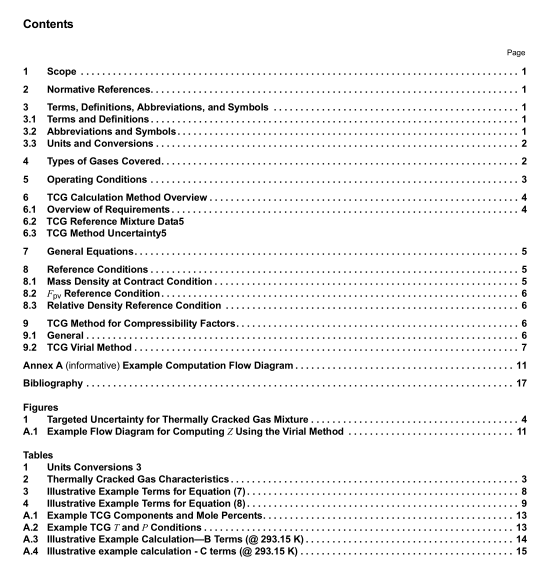API TR 2575 pdf download

API TR 2575 pdf download Measurement of Thermally Cracked Gas
1 Scope
This technical report presents a method to compute the density, compressibility factor, and supercompressibility factorfor thermally cracked gas (TCG) for custody transfer using orifice meters. It provides equations,parameters,computation flow diagrams, and example spreadsheet calculations.
This technical report applies to TCG mixtures after treatment. See Table 2 for more information on the types of gasescovered. It applies for temperature from 90 °F to 120 °F (305 K to 322 K) at pressures up to 300 psig (2 MPa).lt islimited to a specific operating region.The method is for the single gas phase only.
2Normative References
The following referenced documents are indispensable for the application of this document or provide additionalinformation pertinent to mass measurement of natural gas liquids.For dated references, only the edition cited applies.For undated references, the latest edition of the referenced document (including any amendments) applies.
APIl Manual of Petroleum Measurement Standards (MPMS),Chapter 14.2,Compressibility Factors of Natural Gasand Other Related Hydrocarbon Gases (AGA Report No.8 1)(GPA 8185 2)
Terms, Definitions,Abbreviations,and Symbols
3.1Terms and Definitions
The quantities used in the equations in this document are defined when they are used.3.2Abbreviations and Symbols
For the purposes of this document, the following abbreviations and symbols apply.B
second virial coefficient
Bmix
mixture second virial coefficient
bn
constant in Table 4
c
third virial coefficient
mix
mixture third virial coefficient
cn
constant in Table 4
d
mass density (mass per unit volume)
Tp. Pp)
molar density at reference condition Tp. Pp
Fpv
supercompressibility factor
M
molar mass (molecular weight)
M, (air)molar mass of air
M,
molar mass of ith component
N
number of components in gas mixturenumber of moles of gas
P absolute pressure
P b absolute pressure at base conditions
P d reference pressure for density
P gr reference pressure for relative density
R gas constant
T absolute temperature of gas
T b absolute temperature at base conditions
T d
reference temperature for density
T gr
reference temperature for relative density (specific gravity)
V gas volume
x i mole fraction of component the i th in gas mixture
x j
mole fraction of component j in the gas mixture
x k mole fraction of component j in the gas mixture
ρ molar density (mass per unit volume)
ρ (T gr , P gr ) molar density of gas mixture at T gr , P gr
ρ (air, T gr , P gr ) molar density of air at T gr , P gr
ρ b mass density at contract reference base condition T b , P b
Z compressibility factor
Z b compressibility factor at contract reference condition T b , P b
3.3 Units and Conversions
The units used in the basic formulation of the equations and in the associated computer subroutines are SI units.
The subroutines use the following units for the absolute temperature in kelvins (K), pressure in megapascals (MPa), and molar density in moles per cubic decimeter (mol/dm 3 ). The value of the gas constant is 0.008314472 KJ/mol-K. Conversion factors are required for conversions to and from other units. Consistent conversion factors for use with the TCG method are given in Table 1. When possible, the conversion factors given in Table 1 correspond to international standards (GPA 2172-2009 and ISO 6976). Any differences in values used in this program and later values are within the experimental uncertainty in the validation data. Hence any unit conversion changes are unlikely to affect the uncertainty of the calculations. It is recommended that any subsequent changes be ignored unless the agency promoting the change provides a detailed cost impact of the change on industry.
4 Types of Gases Covered
This research document applies to TCG mixtures that may occur in refinery operations. Table 2 provides a simplified list of illustrative TCG mixture example components. A number of components have been excluded either because they were not present in the data or because of low concentration amounts. This shall not be construed to mean those components are not important for TCG calculations. It simply means those components were not available to the research stage data sets. It is recommended that users obtain additional data to validate performance for their fluid mixtures for their operating conditions.









